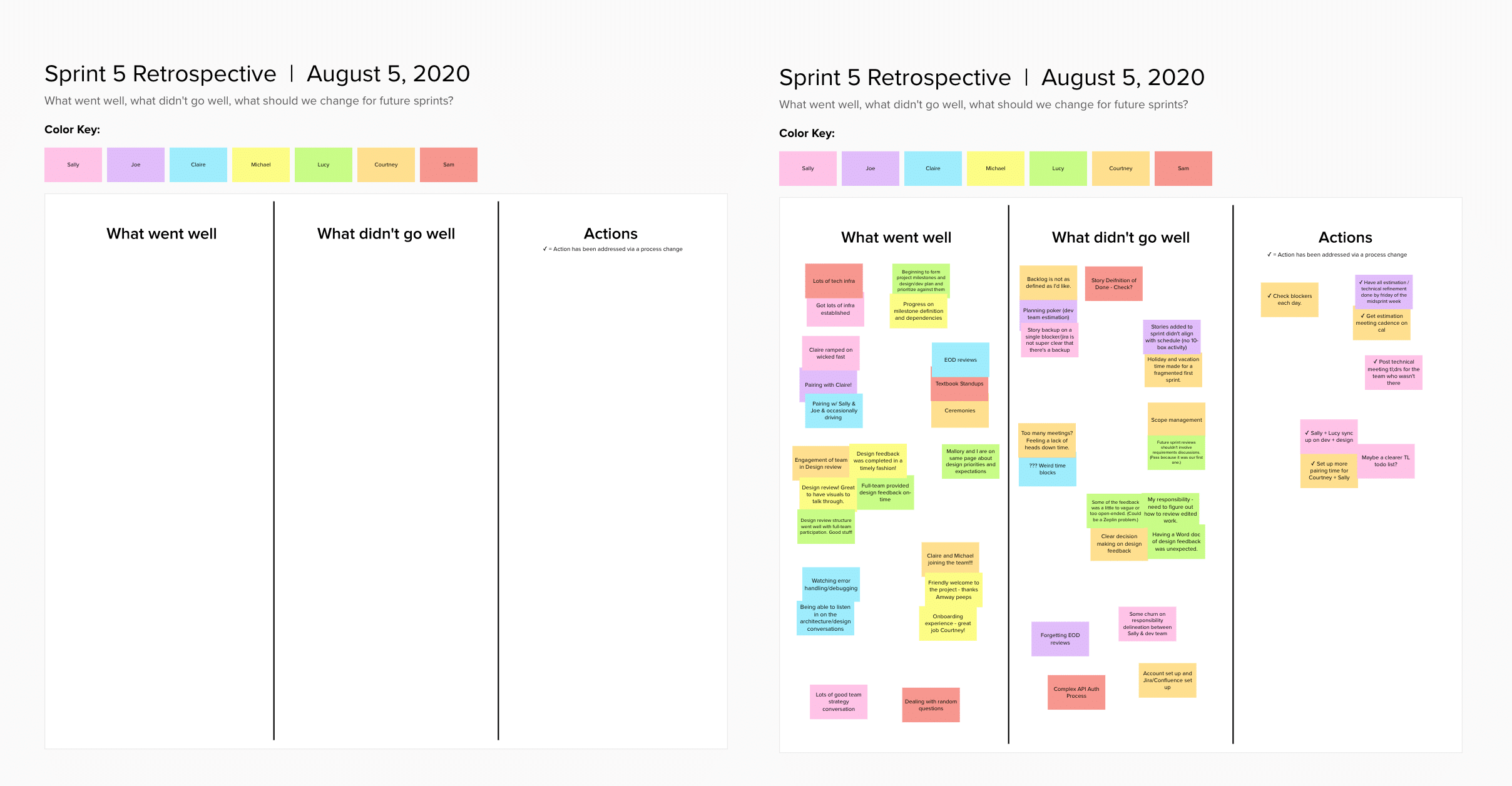Like many companies, Atomic is currently operating remotely due to the Covid-19 pandemic. While software design and development are certainly possible in a fully-remote context, there are a few meetings and tasks that can be more difficult when you can’t be in the same room as your teammates. The sprint retrospective is one of them.
In this post, I’ll give my tried and true tips for a productive remote sprint retrospective.
1. Include the Entire Design & Development Team
It can be tempting to not include everyone in a sprint retrospective, especially when we’re all working remotely and are likely suffering from some Zoom fatigue. But don’t give in to that temptation.
The sprint retrospective is one of the few times the entire team will be in the same virtual room. When done well, it can also be a great team-building opportunity.
Who do I include in the sprint retrospective? I include all developers, designers, testers, and key customer stakeholders. Key stakeholders might be your product owner, technology lead, or customer developers (if your customer has developers).
Don’t include folks who do not actively participate in the sprint. For example, the designer might occasionally work with your customer’s marketing department, but if that interaction is ad hoc and not deeply rooted in your sprint cadence, then marketing does not need to be represented at the sprint retrospective.
2. Encourage Folks to Turn Their Video On
Sprint retrospectives can touch on sensitive topics. When everyone has their video on, it’s easier to pick up on body language, which will better facilitate the conversation. It can be hard to tell if someone is uncomfortable, has a question, or has something important to say when you cannot see their facial expressions.
If you only require video to be on for one meeting throughout your sprint, the sprint retrospective is it.
3. Start with an Icebreaker
Because sprint retrospectives may include difficult conversations, I recommend starting with an icebreaker. This is a great way to lighten the mood and get your remote team feeling comfortable and ready to express potentially vulnerable thoughts.
Adding an icebreaker to the start of the retro also helps recreate one of my favorite aspects of working in person — getting settled in the conference room a few minutes before the meeting starts, chit-chatting with your teammates, and getting to know them better.
4. Utilize a Remote Whiteboard
Don’t simply hop on a Zoom call and start talking without a real plan. Add a bit of collaborative structure to create a more engaging retrospective experience. My team has been using Mural for this with great success.
Be sure to set up a template for your retrospective ahead of time. It can be as simple as three columns. I like to do: what went well, what didn’t go well, and what actions should be taken.
I set up the sprint’s retro space on the first day of the sprint. This way, if folks encounter something they’d like to add to the retro board during the sprint, they have the ability to do so. I do not require anyone to touch the board until the retrospective meeting at the end of the sprint, but some have enjoyed the ability to jot their thoughts down as they arise.
I also strongly recommend assigning a color to each team member. If you have a large team, it can be very easy to forget who wrote what without some color coding.
5. Create Space for Every Person to Speak
After the icebreaker question, I set a timer of five minutes. During this time, the team can add their thoughts to the three columns of the retrospective board. After the five minutes is up, we take turns reviewing our sticky notes.
This practice ensures every member of the team is given equal opportunity to express their thoughts. It also encourages those who might not normally speak up at all to communicate more with the team.
I recommend having one person facilitate and call on speakers individually, or simply follow the order that your color key lays out. This eliminates accidentally talking over each other, which is so easy to do on a call with many people.
6. Use Your Retro Artifact as a To-Do List
The nice thing about utilizing a tool like Mural is that after your sprint retrospective, you still have the retro board to reference in the future. The “actions” column will essentially become a to-do list for your next sprint. Keep track of which actions the team decided they’d like to try out in the upcoming sprint. I recommend visually indicating which actions have been done. I simply add a checkmark to the sticky notes that have been done or initiated.
Retro On!
If your sprint retrospectives are feeling a little lackluster, or if you’re struggling to get the same value out of your remote retrospectives that you did in person, try these tips! It will likely be a while until my team is back to working together in person, but I anticipate we’ll carry some of these practices back to our in-person retrospectives as well.

